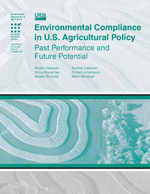Environmental Compliance in U.S. Agricultural Policy: Past Performance and Future Potential
- by Roger Claassen, Vince Breneman, Shawn Bucholtz, Andrea Cattaneo, Robert Johansson and Mitch Morehart
- 5/28/2004
Overview
Since 1985, U.S. agricultural producers have been required to practice soil conservation on highly erodible cropland and conserve wetlands as a condition of farm program eligibility. This report discusses the general characteristics of compliance incentives, evaluates their effectiveness in reducing erosion in the program's current form, and explores the potential for expanding the compliance approach to address nutrient runoff from crop production. While soil erosion has, in fact, been reduced on land subject to Conservation Compliance, erosion is also down on land not subject to Conservation Compliance, indicating the influence of other factors. Analysis to isolate the influence of Conservation Compliance incentives from other factors suggests that about 25 percent of the decline in soil erosion between 1982 and 1997 can be attributed to Conservation Compliance. This report also finds that compliance incentives have likely deterred conversion of noncropped highly erodible land and wetland to cropland, and that a compliance approach could be used effectively to address nutrient runoff from crop production.
Download
-
Entire report
Download PDF -
Research Brief
Download PDF -
Abstract, Acknowledgment, and Contents
Download PDF -
Summary
Download PDF -
Introduction
Download PDF -
Compliance Mechanisms: A Primer
Download PDF -
Current Compliance Mechanisms
Download PDF -
Potential for Extending Compliance: Nutrient Management in Crop Production
Download PDF -
Conclusions
Download PDF -
References
Download PDF -
Appendices
Download PDF

